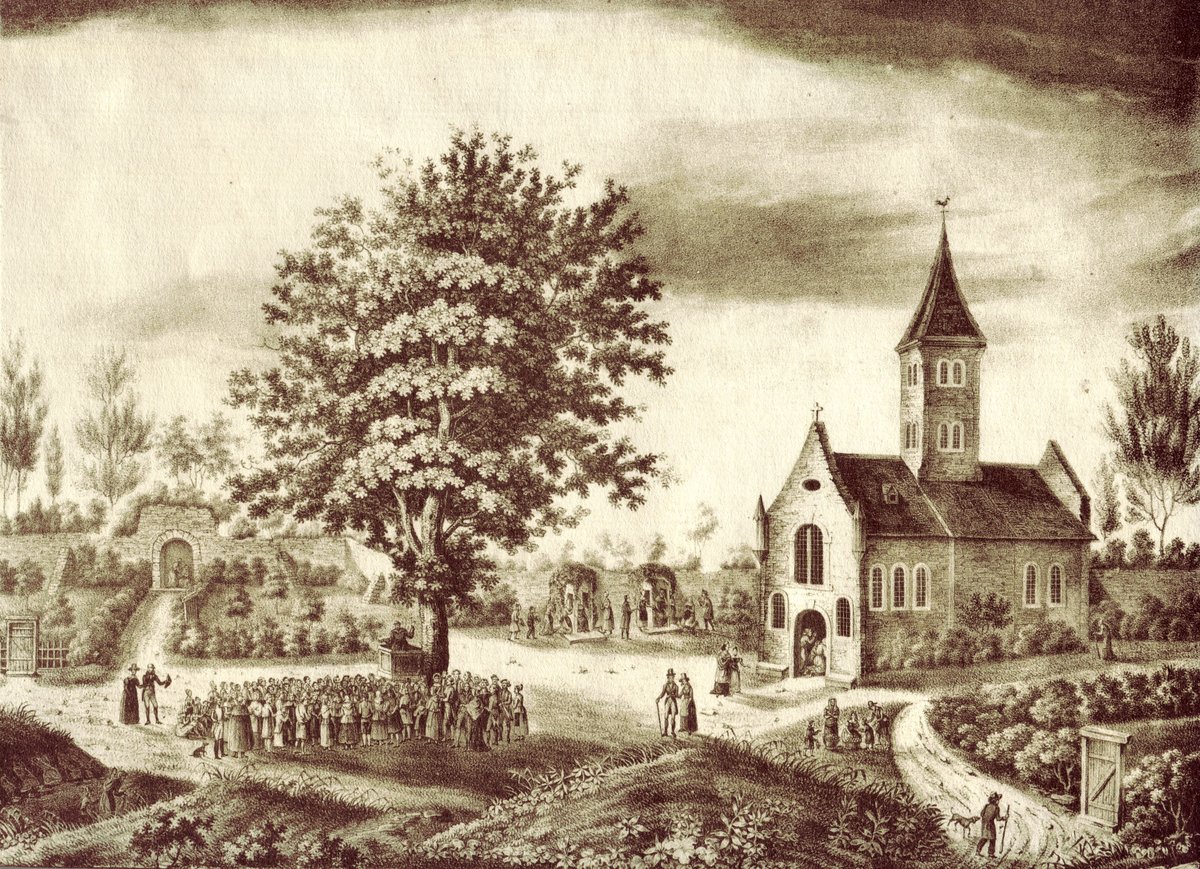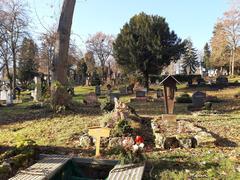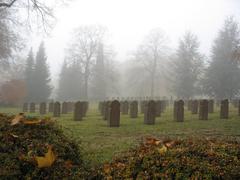
Hauptfriedhof Mainz: Visiting Hours, Tickets, and Historical Significance
Date: 15/06/2025
Introduction
Nestled in the Zahlbach district of Mainz, Germany, Hauptfriedhof Mainz is far more than a burial ground—it’s a living archive of over two centuries of urban history, cultural evolution, and landscape architecture. Established in 1803 during a period of Enlightenment reforms and Napoleonic influence, the cemetery was designed to address public health concerns and reflect neoclassical ideals of order, serenity, and artistry (Wikipedia: Hauptfriedhof Mainz).
Spanning approximately 20–22 hectares, Hauptfriedhof Mainz is both an urban green oasis and an open-air museum. Visitors will find an impressive range of funerary art and architecture, from neoclassical and neo-Gothic monuments to Jugendstil (Art Nouveau) and modern memorials. The grounds are home to notable family mausoleums, war memorials, and a diverse array of grave markers that reflect the social and historical fabric of Mainz (dein-rhein-main.de; wo-sie-ruhen.de).
A unique feature within the cemetery is the historic crematorium, inaugurated in 1903—one of Germany’s earliest—which stands as a symbol of the shift in funerary practices during the 20th century. Although a new facility replaced it in 2010, the original crematorium is a protected monument, slated for adaptive reuse (Flickr: Altes Krematorium des Hauptfriedhofs; Wikipedia).
Hauptfriedhof Mainz is also the final resting place for many distinguished personalities—including artists, scientists, politicians, and industrialists—providing profound insight into the rich heritage of Mainz. In addition, it supports biodiversity and serves as a tranquil urban retreat (mainz.de). The cemetery is open daily, free of charge, and easily reached via public transport. Guided tours and cultural events further enrich the visitor experience, making Hauptfriedhof Mainz a must-see for anyone interested in Mainz’s layered history (wo-sie-ruhen.de; mainzund.de).
Quick Facts
- Location: Zahlbach district, Mainz, Germany
- Establishment: 1803
- Size: 20–22 hectares
- Admission: Free
- Open: Daily, varying hours by season
- Accessibility: Main avenues paved; some paths uneven
- Guided Tours: Available on select dates (check official listings)
Historical Overview
Origins and Establishment
Hauptfriedhof Mainz was founded in 1803 to accommodate a growing population and comply with Enlightenment-era reforms that mandated cemeteries be moved outside crowded urban centers. The founding coincided with the city’s transformation during the Napoleonic era and the shifting borders of the Holy Roman Empire (Wikipedia: Hauptfriedhof Mainz). The cemetery’s neoclassical design emphasized symmetry, order, and landscaped tranquility, and it expanded several times as Mainz grew.
Architectural and Artistic Heritage
A walk through Hauptfriedhof Mainz is a journey through two centuries of funerary art. The cemetery features a broad spectrum of grave monuments, mausoleums, and memorials, many of which are protected as cultural landmarks (Mainz City: Patenschaftsgräber). The layout—shaped by the garden cemetery movement—offers mature trees, meandering paths, and floral displays, making the cemetery a peaceful park as well as a site for remembrance.
Notable Features:
- Gruftenstraßen: Avenues lined with historic family crypts and mausoleums, especially those of the Kupferberg, Henkell, and Schutt families (dein-rhein-main.de).
- Historic Crematorium: Built in 1903 with Art Nouveau elements and a copper dome, it was one of Germany’s earliest crematoria, illustrating evolving burial practices (wo-sie-ruhen.de).
- War Memorials: Ehrenhof (court of honor) established in 1909 for Franco-Prussian War casualties, with memorials for German, French, and Austrian soldiers (Traces of War).
Social Memory and Notable Burials
Hauptfriedhof Mainz is the burial place of many influential figures, such as:
- Jeanbon St. André: French prefect and cemetery founder
- Peter Cornelius: Composer and poet
- Kathinka Zitz-Halein: Writer and women’s rights activist
- Eduard David: First president of the Weimar National Assembly
- Adam Henkell: Wine entrepreneur
- Fritz Strassmann: Chemist, co-discoverer of nuclear fission
- Philipp Veit: Painter
- Karl Holzamer: Philosopher and ZDF founding director
Honorary graves, war graves, and Holocaust memorials underscore the cemetery’s role as a site of collective remembrance (mainzund.de).
Green Space and Biodiversity
Hauptfriedhof Mainz is one of the city’s largest green spaces, recognized for its old-growth trees, flowerbeds, and habitats supporting wildlife such as songbirds, bats, and rare plant species like the round-headed leek (mainz.de). The Sternengarten, a dedicated area for children and infant burials, is especially poignant.
Community Engagement and Preservation
The cemetery’s “grave sponsorship” program allows citizens and organizations to adopt historic graves, supporting their restoration and upkeep (Mainz City: Patenschaftsgräber). This initiative fosters community involvement and helps preserve the site’s heritage for future generations.
Interfaith and Multicultural Dimensions
Adjacent to the main cemetery is the Neuer Jüdischer Friedhof, established in 1881, which highlights the city’s multicultural heritage and the coexistence of Christian and Jewish communities (mainzund.de).
Visitor Information
Location and Access
- Address: Untere Zahlbacher Straße, Zahlbach, Mainz
- Public Transport: Bus and tram stops “Hauptfriedhof” and “Universität” nearby (mainz.de)
- Parking: Limited street parking available
Opening Hours
- April–September: 8:00 AM–6:00 PM
- October–March: 8:00 AM–4:30 PM
- Note: Hours may vary during holidays or special events. Always check the official website for the latest updates.
Tickets and Tours
- Admission: Free of charge
- Guided Tours: Offered periodically; inquire at the cemetery office or local tourist information. Most tours are in German, with English tours available by special arrangement.
Accessibility
- Main Avenues: Paved and suitable for wheelchairs
- Other Paths: Some may be uneven or include steps—contact the administration for accessible routes and facilities.
- Facilities: Benches, water points, and public restrooms at the entrance; administration office for inquiries.
Visitor Guidelines
- Respect: Maintain quiet and decorum; dress modestly
- Photography: Allowed for personal use; avoid photographing mourners or ceremonies
- Pets: Not permitted, except service animals
- Flowers and Candles: May be placed at graves, but do not disturb existing memorials
Highlights and Points of Interest
- Aureustor (Golden Gate): Historic entrance built in 1826
- Historic Mausoleums: Especially along “Gruftenstraßen”
- War and Holocaust Memorials: Including the Ehrenhof
- Jewish Cemetery: Adjacent, with guided visits by arrangement
- Sternengarten: Memorial garden for children and infants
Travel Tips & Nearby Attractions
- Best Seasons: Spring and autumn for pleasant weather and vibrant foliage
- Duration: Allow 1–2 hours for a leisurely visit
- Nearby Sights:
- Rhine river promenade
Frequently Asked Questions (FAQ)
Q: What are the Hauptfriedhof Mainz visiting hours?
A: 8:00 AM–6:00 PM (April–September), 8:00 AM–4:30 PM (October–March), but always confirm with the official website.
Q: Is there an entry fee?
A: No, admission is free.
Q: Are guided tours available?
A: Yes, tours can be arranged through the cemetery office or local tourist information.
Q: Is the cemetery wheelchair accessible?
A: Main avenues are accessible, but some paths may be uneven.
Q: Can I visit the Jewish cemetery?
A: With prior arrangement through the Jewish community (Jüdische Kultusgemeinde Mainz-Rheinhessen).
Q: Are pets allowed?
A: Only service animals.
Conservation and Community
The city of Mainz, together with local heritage groups, actively maintains and restores the cemetery’s cultural assets through grave sponsorships, guided tours, and educational events (Mainz City: Patenschaftsgräber). These efforts sustain Hauptfriedhof Mainz as both a site of memory and a green urban haven.
Visuals
Summary and Recommendation
Hauptfriedhof Mainz is a unique convergence of history, art, nature, and memory, making it an essential destination for anyone interested in the heritage of Mainz. Its neoclassical avenues, diverse monuments, and commitment to preservation invite visitors to reflect on the city’s past and present. Combine your visit with other Mainz landmarks like the cathedral and Gutenberg Museum for a rich, immersive experience. For interactive guided tours, download the Audiala app and follow local listings for cultural events.
Official Resources and Sources
- Wikipedia: Hauptfriedhof Mainz
- Wo-sie-ruhen.de: Hauptfriedhof Mainz
- Geographie für Alle: Hauptfriedhof Mainz
- Mainz.de: Friedhöfe
- Mainz City: Patenschaftsgräber
- Significant Cemeteries: Main Cemetery of Mainz
- Flickr: Altes Krematorium des Hauptfriedhofs
- dein-rhein-main.de: Hauptfriedhof Mainz
- mainzund.de: Patenschaftsgräber auf dem Hauptfriedhof Mainz




































































































































